Legendary Mopar® Pro Stocker: 1971 Motown Missile Challenger!
– Historically significant specimen of NHRA drag racing’s early Pro Stock class
– A rolling research and development testbed vehicle that also was raced in competition
– Chrysler’s NASA Rocket Aerospace Technology Program was integral part of the drag strip testing
The late 1960s saw a hugely popular “Super Stock” category in the National Hot Rod Association (NHRA) scene, and the various cars that raced in the eliminator ran on a handicapped basis. In other words, slower cars would get a “head-start” on the Christmas Tree over the quicker cars, and the race to the finish line came on whichever car ran best with their power and the driver’s reaction time. Chrysler Corporation cars were known to typically have the quickest cars as they ran HEMI® engines oftentimes, and had to chase down lower class cars to the finish line.
While there were huge amounts of these S/S cars running, starting in 1967 with 10 classes, then in 1969 there was a movement by a handful of racers to not compete in that handicapped system, but to rather run “heads-up” which mean both cars leave at the same time on the Christmas Tree and race all-out to the finish line. Mustangs, Barracudas and Camaros did this and they ran big-block engines (426- and 427-cubic-inch) and shifted via manual 4-speed transmissions. They were called “Match Race” cars and the crowds loved them!
A proposal was put to the NHRA to create a brand-new class, to be called “Pro Stock” and it would allow GM, Ford and Chrysler racers to compete on an equal basis based on the rules. The agreed-upon rules revolved around these cars factored at seven pounds per cubic inch, a weight minimum of 2,700 pounds, and either two four-barrel or four two-barrel carburetors. NHRA allowed the use of fiberglass replacement hoods, front fenders, splash pan and deck lid. The rest of the car was basically like a Super Stocker.
HEMI MOPAR® ENGINES


Chrysler Corporation racers mostly chose the new 1970 Plymouth Barracuda and Dodge Challenger E-body cars with race-prepped 426 HEMI engines, a few initially ran left-over S/S Darts and Barracudas from 1968 that were upgraded to A/Modified Production status. However, any racer that had factory support went with the new body style as that was what the factory dictated for use. After all, the goal was to help sell brand-new cars on the showroom! Big Holley 4500-series Dominator carburetors and high-rise tunnel rams were chosen for induction, and for each team including Plymouth’s Sox & Martin, Dodge’s Dick Landy, two of the main factory-backed entries, they could set up their own suspension systems as well as their internal engine modifications as they saw fit.
ENTER THE MOTOWN MISSILE

A very special in-house Chrysler project car came about during the 1970 racing season called the “Motown Missile” and it was a 1970 Dodge Challenger built under the supervision of Ted Spehar, and driven by Dick Oldfield. Mr. Tom Hoover was the boss of the operation. While it was a full-on racecar, it actually doubled as a test and development vehicle, and the intent was to gather important data from the runs it made and to share that information with the various Dodge and Plymouth racers that were either fully factory-backed or received assistance from the factory. Because there were some drivers such as Ronnie Sox and Butch Leal, as examples, that were super talented with rapid shifting of the 4-speed transmissions, there was a decision by the Chrysler racing brass to develop an automatic transmission for the Motown Missile, as a means of providing a way to give a more equal opportunity to win races. B&M Transmissions in California assisted and even though a great deal of effort was put into developing a tricked-out “ClutchFlite six-speed” for the application, it later was decided to go with the traditional Chrysler race-prepped 4-speed manual gearbox. And as such, the hot-shoe drivers did have an advantage because of their prowess with a short-throw Hurst shifter!
UPDATED TO 1971 TRIM AND NEW GRAPHICS


There were changes made to the car for the 1971 racing season, updated current model year grille and taillights, plus ace driver Don Carlton came on as the new driver, a huge talent and very consistent behind the wheel, very important for the testing procedures. This saw the Motown Missile now running more consistently in private testing as well at sanctioned race events. This was done not only as a way to get more track time with the car but also to give Chrysler more chances for a win, plus of course exposure for the Dodge Challenger brand. All the while there was development work and A-B-A tests on engine, transmission and differential preparations as well as hood scoop, suspension systems and wheelie bar design to name a few areas of attention given.
One aspect of the Motown Missile that separated it from all other Pro Stock cars at the time was the connection it had with the Chrysler NASA Rocket Development Division (located in Huntsville, AL) that incorporated all kinds of aerospace technology, in the way of exotic testing equipment and DAQ (data acquisition) for when the car was traveling down the race track. A Dodge van accompanied the car when it was being tested, and inside was special metering and recording equipment. This was total state-of-the-art in 1971 for any type of motorsports!
SIXTEEN SPARKPLUGS

A dual distributor ignition system was incorporated into the engine program, now firing two spark plugs per combustion chamber. The Accel design was a secondary distributor attached at a 90-degree angle. The engine block had been milled for weight reduction, and the cylinder heads from aluminum. The internals, cam specs, compression ratio and other components were always in a constant change of flux as there was extensive testing going on throughout the cars history. All the data and everything learned was immediately shared to the other Mopar® Pro Stock racers, as that was the whole purpose of the project.
INTERIOR


Early Pro Stock cars had minimal interior frills. Lightweight replica dash, cable-drive SW tach, race buckets, short-throw Hurst shifter, line-loc, simple roll cage and carpet. This is when the Pro Stock class had cars that looked pretty stock, even the interior door panels were retained.
LOOKS ARE DECEIVING
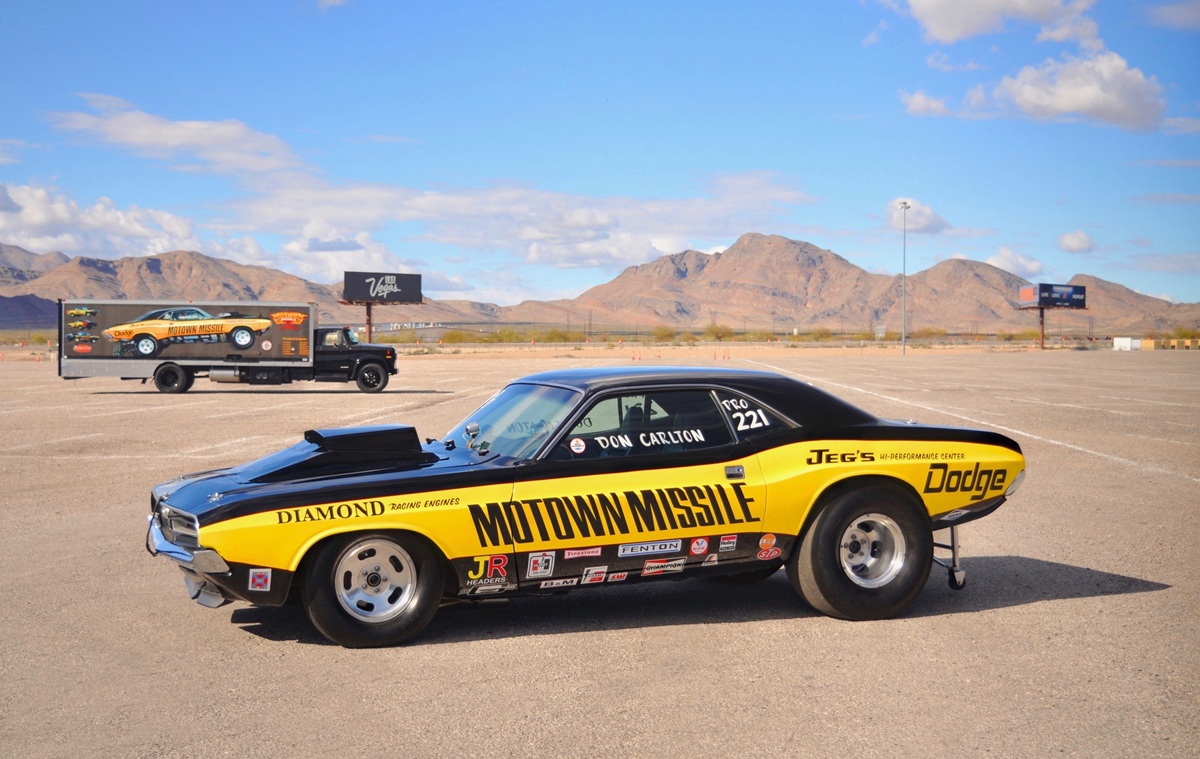
While the car may look like a “real” showroom Challenger of the era, there’s actually a lot going on with its construction. The body was chemically milled (AKA acid dipped) for weight removal, and extensive use of titanium was used in many components of the car. When author Alex Walordy did a full article on the car when it was run in 1971, here’s what he wrote about its preparation: “When the body was thoroughly lightened, the team came up with a frame-within-a-frame – a roll cage with rails tying into the front suspension and then back to the rear suspension. There isn’t a part on the car that hasn’t been modified somehow, changed, lightened or improved upon.”


Narrowed Dana 60 runs 9 3/4-inch ring gear and 5.12 gears. The wheelie bars were fitted with cushioning valve springs inside the tubes, with heavier spring rates on the passenger’s side to help deal with the engine’s rotation of putting more force to the RH side when launching.
DETAILS MATTER



During the resto process, there was a lot of research done to properly bring the car’s details back to when it was campaigned all those years ago. Included was the correct “Dodge” font for the license plate, the finding of the correct Fenton lightweight aluminum “slot” wheels, and to replicated the rainbow/missile artwork of “Greg of Akron” who was a highly acclaimed racecar artist of the era.
CURRENT CARETAKER
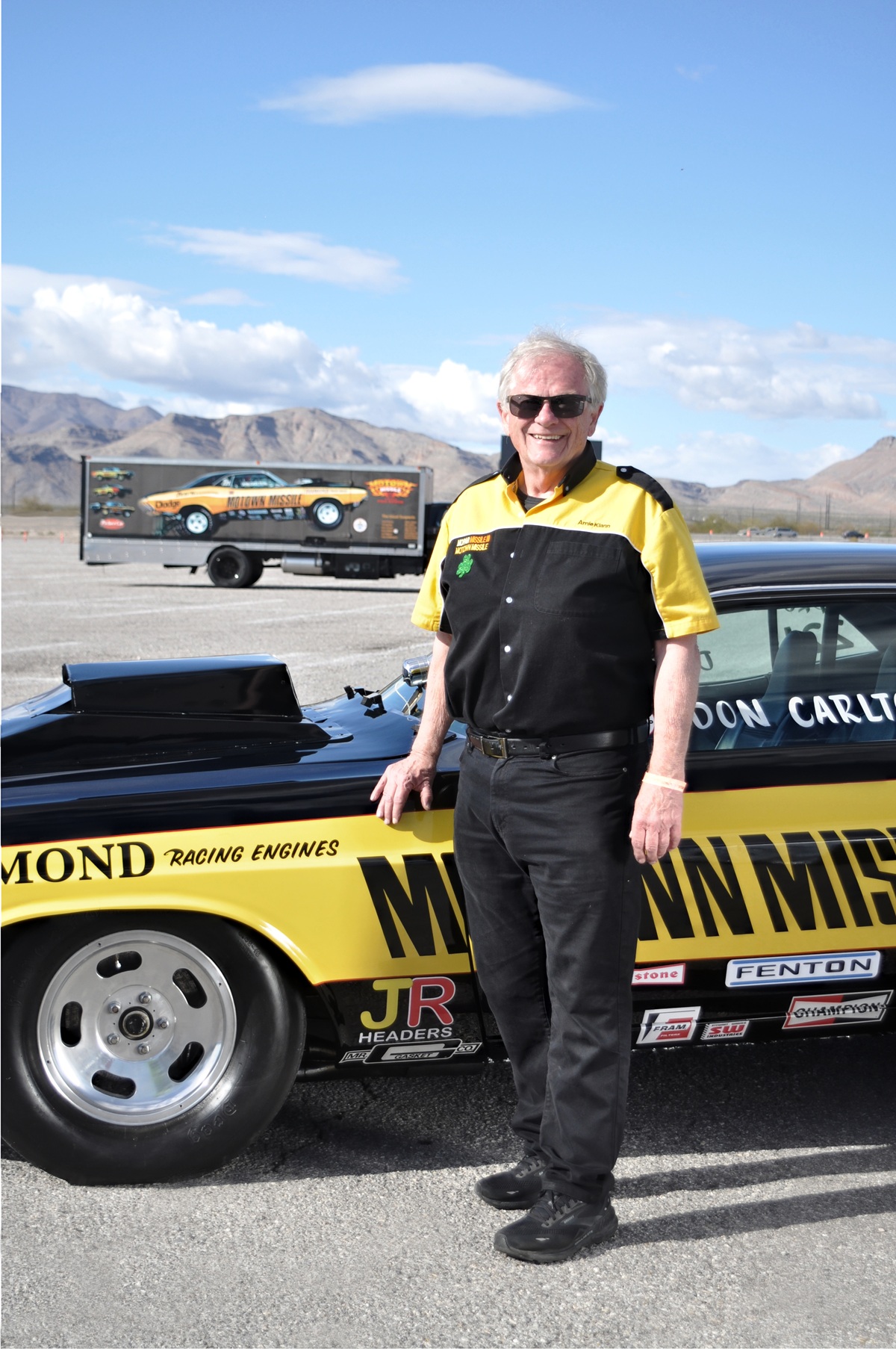
You know you’re a serious Mopar fanatic when one of your very first cars was a HEMI Road Runner! That is the case of car owner Arnie Klann! He, in fact, saw this Motown Missile Challenger race in his native Ohio when he was a young man and right from the get-go he saw it was a very sophisticated racecar. All these years later, he purchased it and has brought it up to accurate condition. Arnie has owned and operated the team with modern-era Mopar Avengers and Neons on the NHRA circuit. In addition, he restored and owns the one-of-a-kind “Mopar Missile Wire Car” that was built with Formula One design technology, driven by the late Don Carlton.
RETRO RIG DODGE HAULER




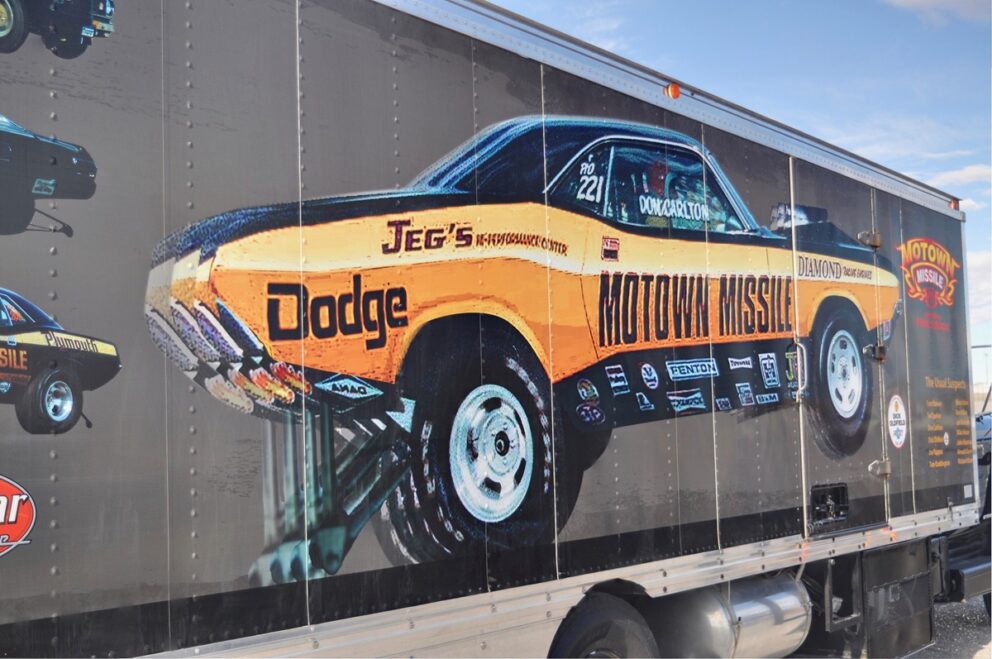

Titled as a 1973, this vintage 26′ cargo box Dodge D600 Truck is an awesome manner of hauling a historical Mopar Pro Stock car! When you add in that the 413-powered rig was originally custom-built brand-new for Chrysler factory racer Judy Lilly, AKA “Miss Mighty Mopar,” it adds a special amount of very unique nostalgia flavor! The legendary car that is hauled in the rig has tons of pedigree and everywhere it goes there’s a crowd admiring it and asking questions.
BACK IN THE DAY
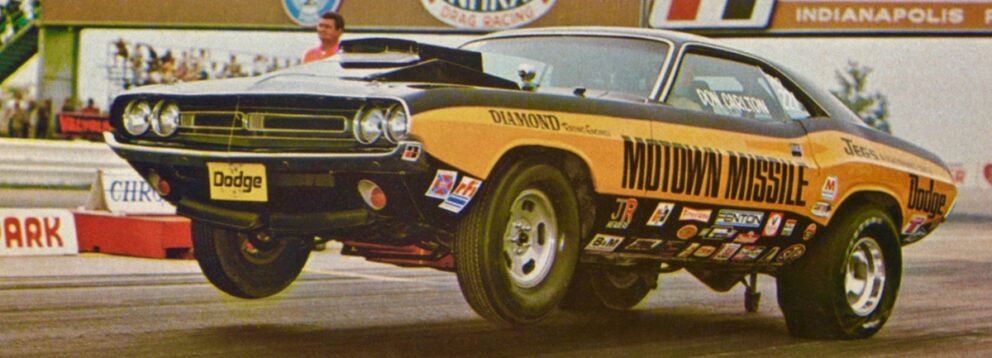
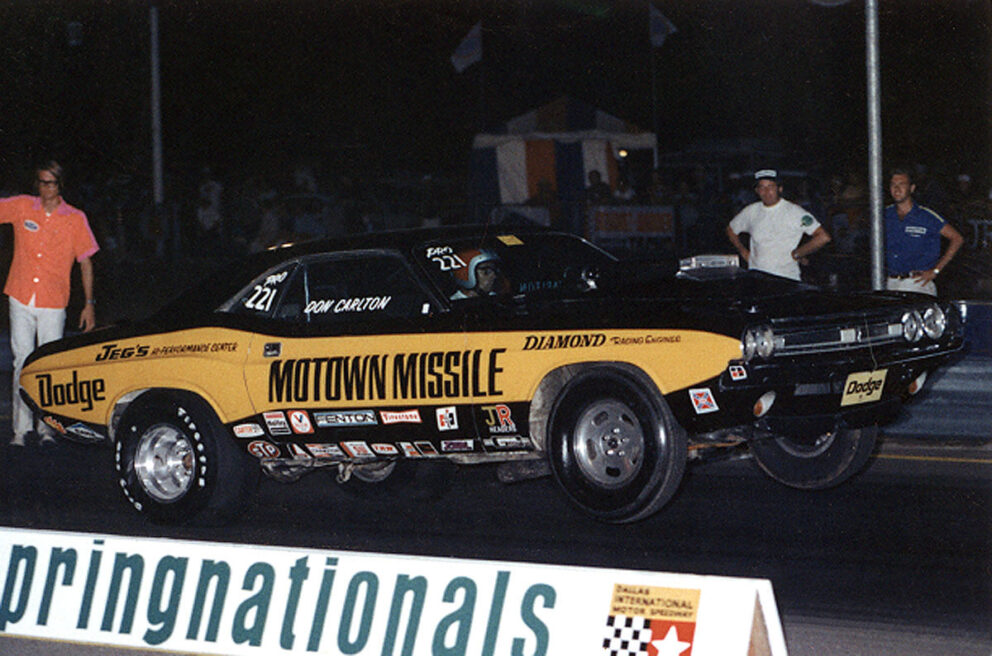
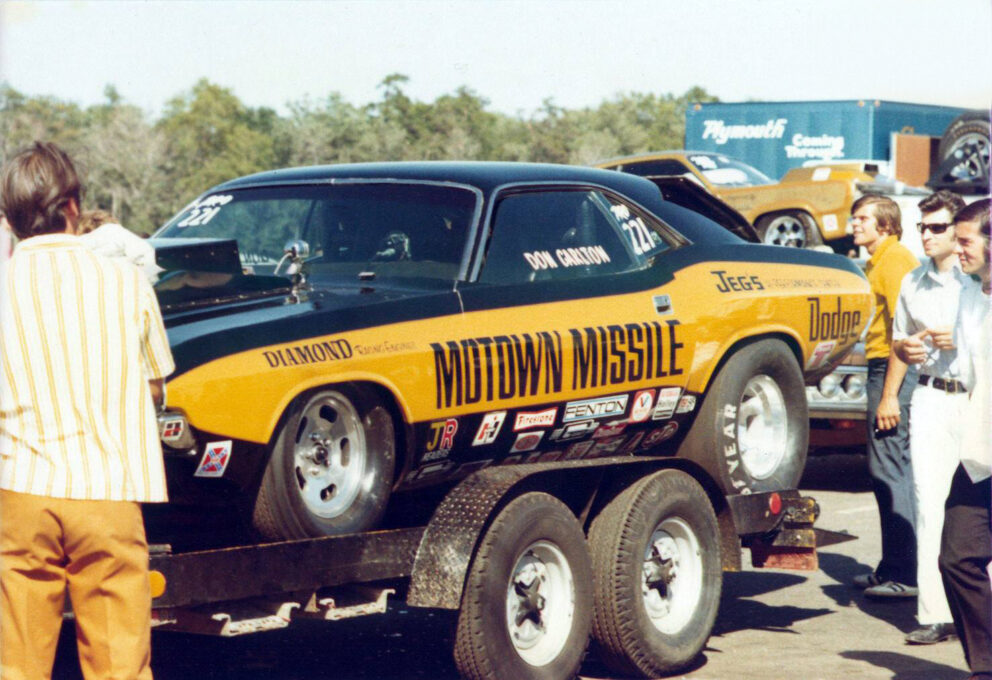
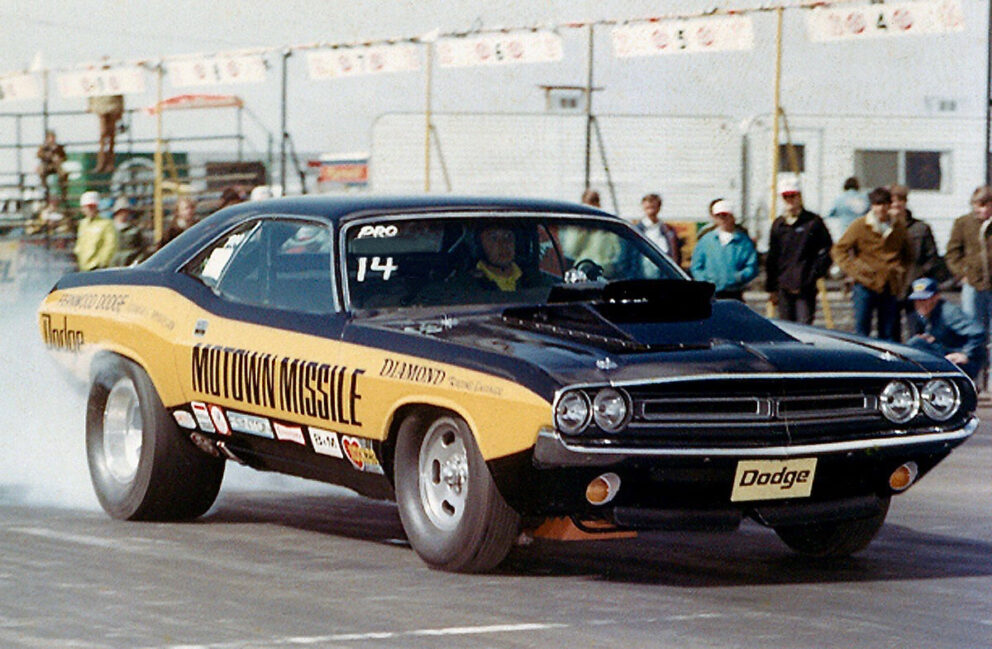
“The Motown Missile is the ultimate in scienced-out race cars, and has set a pattern that all the other MoPars are following. It has run 9.59 at 143 mph seemingly with ease.” That’s how Super Stock & Drag Illustrated Magazine reported on it in their May 1971 issue. The car dipped into the low 9.40s in excess of 149 mph with further development.
THE BOOK
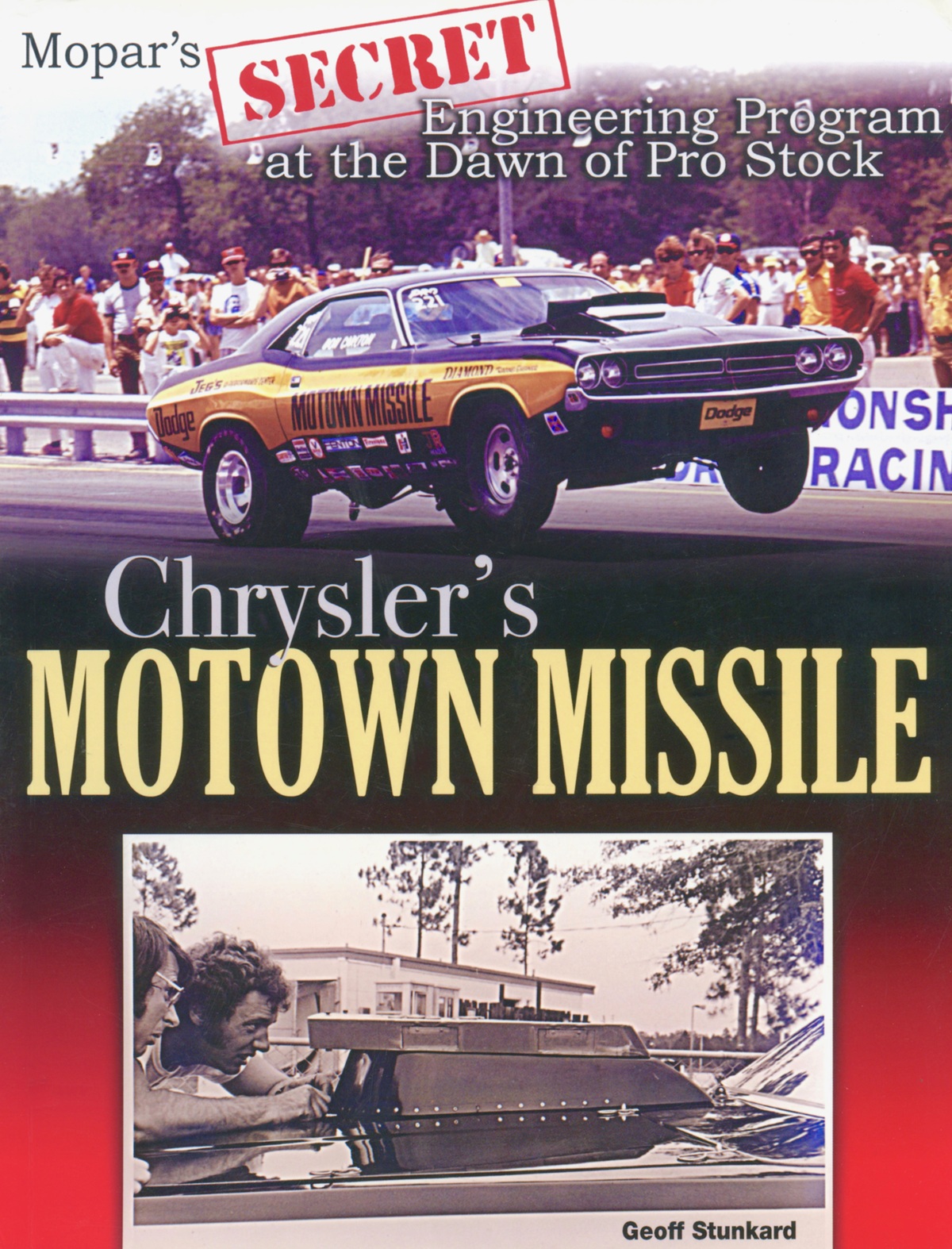
The 176-page Chrysler’s MOTOWN MISSILE book by Geoff Stunkard is the ultimate information source for all things Motown Missile! Inside, there are nine chapters that covers every aspect of the car, and it also extends on to the Motown Missile ’72 Barracuda Pro Stock, the “Mopar Missile” Duster and the over-the-top exotic “Wire Car” that was outlawed by NHRA before it even saw a race track! If you enjoy Mopar Pro Stock extensive history, including HEMI Colts, this is a must-read publication. Originally published by CarTech Books. ISBN# 978-1-61325-475-2
EXTREMELY POPULAR AND RECOGNIZED AS AN ICONIC RACECAR







The Motown Missile Challenger has long been a favorite with enthusiasts and over the years there’s been custom-built 1/25th scale plastic kits built as well as now-out-of-production 1:18 metal diecasts. There’s been artwork drawn on the car and it was also featured on the cover of the July 1989 edition of High Performance MOPAR magazine.


Merch featuring the infamous Motown Missile can be found on just about anything these days, which is further proof of how popular this car has remained.
Author: James Maxwell

0 Comments